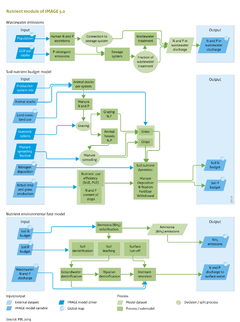Nutrients/Description: Difference between revisions
Jump to navigation
Jump to search
No edit summary |
Oostenrijr (talk | contribs) m (Text replace - "N2 " to "N<sub>2</sub> ") |
||
| Line 29: | Line 29: | ||
Stored animal manure available for cropland and grassland application includes all stored and collected manure, excluding ammonia volatilisation from animal houses and storage systems. In general, IMAGE assumes that 50% of available animal manure from storage systems is applied to arable land and the rest to grassland in industrialised countries. In most developing countries, 95% of the available manure is spread on croplands and 5% on grassland, thus accounting for the lower economic importance of grass compared to crops in these countries. In the European Union, maximum manure application rates are 170 to 250 kg N per ha , reflecting current regulations. | Stored animal manure available for cropland and grassland application includes all stored and collected manure, excluding ammonia volatilisation from animal houses and storage systems. In general, IMAGE assumes that 50% of available animal manure from storage systems is applied to arable land and the rest to grassland in industrialised countries. In most developing countries, 95% of the available manure is spread on croplands and 5% on grassland, thus accounting for the lower economic importance of grass compared to crops in these countries. In the European Union, maximum manure application rates are 170 to 250 kg N per ha , reflecting current regulations. | ||
====Biological | ====Biological N<sub>2</sub> fixation==== | ||
Data on biological | Data on biological N<sub>2</sub> fixation by leguminous crops (pulses and soybeans) are obtained from the N in the harvested product (see nutrient withdrawal) following the approach of ([[Salvagiotti et al., 2008]]). Thus any change in the rate of biological N<sub>2</sub> fixation by legumes is the result of yield changes for pulses and soybeans. In addition to leguminous crops, IMAGE uses an annual rate of biological N<sub>2</sub> fixation of 5 kg N per ha for non-leguminous crops and grass, and 25 kg N per ha for wetland rice. N fixation rates in natural ecosystems were based on the low estimates for areal coverage by legumes ([[Cleveland et al., 1999]]) as described by Bouwman et al. ([[Bouwman et al., 2013a|2013a]]). | ||
====Atmospheric deposition==== | ====Atmospheric deposition==== | ||
Revision as of 10:37, 1 July 2014
Parts of Nutrients/Description
| Component is implemented in: |
| Components: |
| Related IMAGE components |
| Projects/Applications |
| Key publications |
| References |
